Pseudolarix amabilis (golden larch)
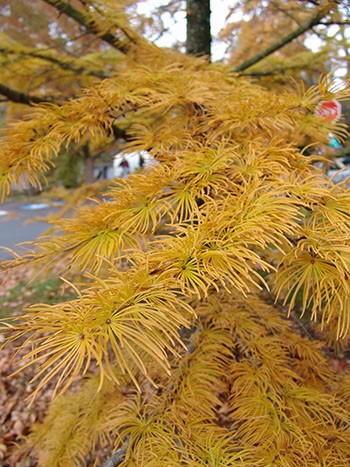 Deciduous conifers can be a confusing term to the plant novice. I assure you, it is a group to be cherished. You may be familiar with Taxodium, Metasequoia, and Ginkgo, all of which are noted for their amazing fall color, longevity, and tolerance. I would like to bring to your attention two other genera with similar landscape uses and seasons of interest.
Deciduous conifers can be a confusing term to the plant novice. I assure you, it is a group to be cherished. You may be familiar with Taxodium, Metasequoia, and Ginkgo, all of which are noted for their amazing fall color, longevity, and tolerance. I would like to bring to your attention two other genera with similar landscape uses and seasons of interest.
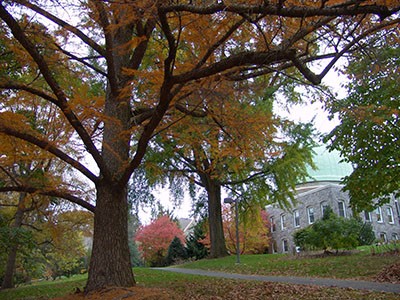
For weeks I have passed between the Sproul Observatory and the tennis courts scanning the Pinetum for a glimpse of fall color because I know what’s coming … Pseudolarix. photo credit: R. Robert
I am, of course, speaking of Larix and Pseudolarix. I first became aware of these two genera at The Arnold Arboretum last summer, and was excited to discover there are fourteen of these outstanding plants in the Scott Arboretum. For weeks I have passed between the Sproul Observatory and the tennis courts scanning the Pinetum for a glimpse of fall color because I know what’s coming … Pseudolarix.
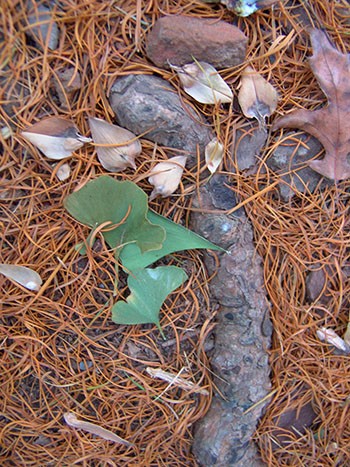
The needles dehisce in the fall creating a beautiful carpet beneath the tree. photo credit: R. Robert
Why two genera? Pseudolarix is described as having larger cones with pointed scales that tend to shed as the fruit matures and the catkins form in clusters, while Larix catkins form in singles and the cone fall off whole when ripe.
Of the six species represented at the Scott Arboretum the most suitable for this area appears to be the Pseudolarix amabilis. This specimen requires full sun and moderate water to establish; preferring acidic soil, Pseudolarix can mature at sixty feet.
A large specimen will have nice splotchy grey bark and elegant branch unions. The needles emerge as light green umbrella-like structures similar to Sciadopitys. In fall, the needles turn gold or deep bronze and when they dehisce they create a beautiful carpet beneath the tree. The lime green fruit tends to appear en masse and add to the appeal of the tree.
I always find myself drawn to plants with multiple seasons of interest. Pseudolarix scores big in all seasons and will definitely make any homeowner’s collection unique. Very difficult to come by in retail, so most suggest propagating by seed. As young plants they grow rapidly and more slowly as they mature, making for instant shade where space it limited or as a stand-alone specimen to enjoy all of its glory.





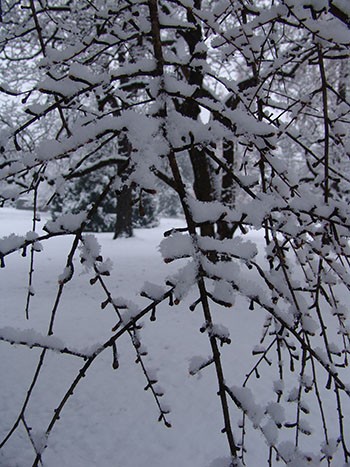
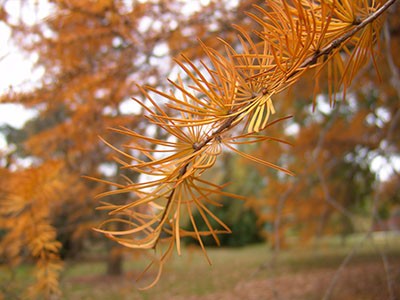
Becky Michael
Posted at 10:11h, 21 OctoberI have a 15-year-old golden larch in my backyard. I love this tree. When it was little, a white pine fell on it and I thought it wouldn’t make it. I lifted off the pine, the tree sprung back and is growing straight and true. It is so majestic and is the most easy-to-get-along-with tree. It hardly needs any pruning. The fresh needles in spring are lovely, soft and green and their golden buttery color in the fall is absolutely amazing. Right now it has its most interesting pine cones on it. Last year I thought I could use them in decorations until I realized the cones fall onto the ground into little pieces, disappearing into the landscape. I can’t speak highly enough about the golden larch!
Becky Robert
Posted at 10:17h, 21 OctoberBecky, This is totally one of my favorite fall color trees too! The magic of deciduous conifer is wonderful.
Becky Robert
Scott Arboretum